Marguerite Gérard
| Marguerite Gérard | |
|---|---|
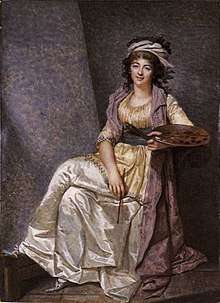 Marguerite Gérard, by François Dumont | |
| Born |
28 January 1761[1] Grasse, France |
| Died |
18 May 1837 (aged 76) Paris, France |
| Nationality | French |
| Known for | painting, etching |
| Style | Genre art |
Marguerite Gérard (28 January 1761 in Grasse – 18 May 1837 in Paris)[1] was a French painter and etcher. She was the daughter of Marie Gilette and perfumer Claude Gérard. At 8 years old she became the sister-in-law of Jean-Honoré Fragonard, and when she was 14, she came to live with him. She was also the aunt of the artist Alexandre-Évariste Fragonard. Gérard became Fragonard's pupil in the mid-1770s and studied painting, drawing and printmaking under his tutelage. Gérard and Fragonard created nine etchings in 1778. Historians currently believe Gérard was the sole artist of five of the etchings since many have a duplicate created by Fragonard as he taught Gérard.[2]
Personal life
Upon the death of her mother in 1775, Marguerite Gérard, the youngest of the seven children, took up residence in the Louvre with her sister and her sister's husband Jean-Honoré Fragonard.[3] She lived in the Louvre with them for approximately thirty years, allowing her to view and be inspired by great artworks of the past and present.[4] Of particular interest to Gérard were the genre scenes of the Dutch Golden Age which she would emulate in her own work. She was offered a spot at the Académie Royale de Peinture et de Sculpture but turned it down.[5] Her association with Fragonard's circle allowed Gérard the freedom to remain unmarried without becoming a financial burden to herself or her parents; this allowed her devote her life to becoming an artist, a career she continued for over fifty years.[4][3] Speculation that Gérard and Fragonard were lovers has been thoroughly disproved, and Gérard referred to the older artist as a father figure.[4] After the death of Fragonard she continued to live with her sister for 17 years.[4]
Artwork
Marguerite Gérard began her work as an artist in the 1770s while living in Paris. Her earliest compositions are etchings and engravings, while her later and more renowned works are oil paintings.[6] As a woman, Marguerite did not have access to academic training and could not study the nude, thus the early stages of her training relied upon studying Fragonard's work.[4] Making engravings was a common studio practice at the time; Fragonard himself learned engraving from his master François Boucher. [2] Gérard's informal apprenticeship and study of 17th century Dutch painters helped her develop her own style.[4] The collaboration of Gérard and Fragonard is rather unusual, but Gérard's skills improved to a point where she made small contributions to Fragonard's oil paintings.[3] Her artwork depicts scenes in everyday life, a style known as genre painting. Her works were exhibited in the Paris Salon beginning in the 1790s and garnered the attention of wealthy patrons.[7]
Influences
Gérard became interested in art while living with her sister, Marie-Anne Fragonard, and brother-in-law, Jean-Honoré Fragonard, in Paris. She aspired to become an artist like her sister, a painter of miniatures, and her brother-in-law encouraged her ambitions. She began training with Fragonard at age 16[8]. She became an unofficial apprentice of Jean-Honoré Fragonard, working from his drawings to create her first pieces of work; soon after, she began to create her own genre paintings.[2][6] The depiction of everyday life in the artwork closely resembles the style of Gerard Ter Borch and Gabriel Metsu, Dutch artists from the seventeenth century.[6] Much like these Dutch artists, Gérard painted meticulous details using finely blended brushstrokes.[7] Her unpretentious paintings represented the major underground current in the art of the early 1800's. Depicting the minor domestic dramas in the homes of the rich middle class, Marguerite Gérard not only paved the way for other women artists, but also men of the next generation, including her nephew Alexandre Evariste, to whom she tried to be what Fragonard had been to her.[9]

Subjects
As a genre artist, Gérard focused on portraying scenes of intimate domestic life. However, unlike other female painters who liked the refer to classical antiquity, Marguerite Gérard often used costumes and settings from a few centuries earlier.[9] Domestic cats and dogs also show up repeatedly in Gérard's work. Many of her paintings illustrate the experiences of motherhood and childhood within the home, and several emphasize the importance of music and female companionship.[6] One of her more ambitious engravings, The Genius of Franklin (Le Génie de Franklin), depicts an allegorical scene of Benjamin Franklin and America personified as a woman. This engraving's subject matter helped introduce Gérard's work to a larger audience since prints could be produced easily. [2] Gérard also painted at least thirty-five portraits of painters, actors, and patrons between 1787 and 1791.[7]
Reception and recognition
Gérard was one of the better-known women artists during her time. By 1785, she had established a reputation as a gifted genre painter and was one of the first french women to do so.[4] Her art was advertised with the phrase "sous les yeux de Fragonard" (under the eyes of Fragonard) to give her early work credence; however, it has caused many art historians to overestimate Fragonard's role in her art. By her mid-20s, Gérard has developed her signature style, which featured painstakingly accurate details rendered with subtly blended brush strokes.[6] It is currently accepted that Gérard made the five etchings in 1778 by herself based on Fragonard's drawings.[2] After the Revolution, once the Salons began accepting art created by women, Gérard exhibited from 1799 to 1824.[4] Despite her lack of formal training, she won three medals for her artwork.[5] One of her paintings, The Clemency of Napoleon, was purchased by Emperor Napoleon in 1808.[6] Other patrons include Louis XVII and various members of the upper class.[5] Wealthy collectors purchased original paintings to display in their homes, while engravings of her paintings were spread among the middle class.[7] Both the impressive technique and relatable subject matter led Gérard's artwork to become popular with the people of France.
Gallery
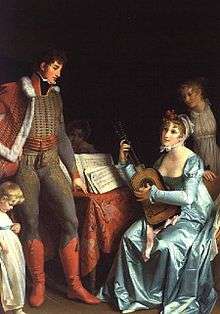 La duchesse d'Abrantès et le général Junot (Duchess of Abrantès and General Junot), oil on canvas, ca. 1800
La duchesse d'Abrantès et le général Junot (Duchess of Abrantès and General Junot), oil on canvas, ca. 1800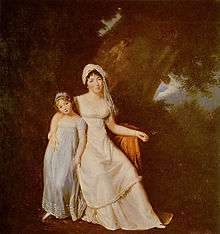 Mme de Staël et sa fille Albertine (Mme de Staël and her daughter Albertine), oil on canvas, 1803–1808
Mme de Staël et sa fille Albertine (Mme de Staël and her daughter Albertine), oil on canvas, 1803–1808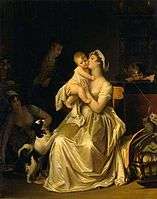 La Maternité (Motherhood), oil on canvas, 51 x 61 cm, 1795–1800
La Maternité (Motherhood), oil on canvas, 51 x 61 cm, 1795–1800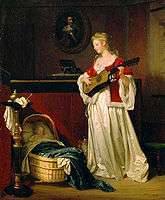 Dors, mon enfant (Sleep my child), oil on canvas, 55 x 45 cm, 1783–1786
Dors, mon enfant (Sleep my child), oil on canvas, 55 x 45 cm, 1783–1786 Peintre faisant le portrait d'une joueuse de luth (Painter when painting a portrait of a lute player), 61 x 51.5 cm, before 1803
Peintre faisant le portrait d'une joueuse de luth (Painter when painting a portrait of a lute player), 61 x 51.5 cm, before 1803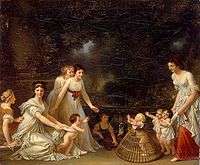 First steps, oil on canvas, 45.5 x 55 cm, ca. 1788
First steps, oil on canvas, 45.5 x 55 cm, ca. 1788 Le déjeuner du chat ("The Cat's Lunch"), oil on canvas, Musée Fragonard, Grasse, France
Le déjeuner du chat ("The Cat's Lunch"), oil on canvas, Musée Fragonard, Grasse, France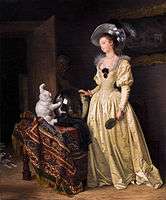 Le chat angora, oil on canvas, 1780, 65 x 53.5 cm
Le chat angora, oil on canvas, 1780, 65 x 53.5 cm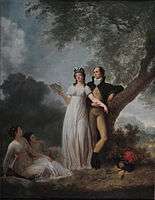 The Song, oil on canvas, 1785
The Song, oil on canvas, 1785
References
- 1 2
Sardou, J. B. (1865). Inventaire sommaire des Archives communales antérieures à 1790, ville de Grasse. Paul Dupont. p. 11. Retrieved 12 May 2009.
Acte de naissance de mademoiselle Marguerite Gérard, peintre, décédée en 1832, le 1er janvier : « Le 28 janvier 1761, est née et a été baptisée Marguerite Gérard, fille du sieur Claude Gillette Gérard, marchand parfumeur, et de dame Marie, son épouse; le parrain a été Honoré Isnard, négociant, la marraine demoiselle Marguerite Gazagnaire, son épouse »
.
Note that contrary to all other sources, the given death date is 1 January 1832, not 18 May 1837. - 1 2 3 4 5 Rena M. Hoisington and Perrin Stein, "Sous les yeux de Fragonard: The Prints of Marguerite Gérard," Print Quarterly, XXIX, no. 2, 2012, pp. 142-162.
- 1 2 3 Nochlin, Linda; Harris, Ann Sutherland (1977). Women Artists 1550-1950 (1st ed.). Los Angeles: Los Angeles County Museum of Art. p. 197. ISBN 9780394733265.
- 1 2 3 4 5 6 7 8 Robertson, Sarah Wells. "Gérard, Marguerite". Grove Art Online. Oxford Art Online. Oxford University Press. Retrieved 8 March 2015.
- 1 2 3 "Marguerite Gérard (1761-1837, French) - THE GREAT CAT". THE GREAT CAT. Retrieved 2017-03-30.
- 1 2 3 4 5 6 "Royalists to Romantics: Spotlight on Marguerite Gérard". Broad Strokes: The National Museum of Women in the Arts' Blog. 2012-04-03. Retrieved 2017-03-17.
- 1 2 3 4 "Marguerite Gérard | National Museum of Women in the Arts". nmwa.org. Retrieved 2017-03-17.
- ↑ Stein, Perrin. "Perrin". Metropolitan Museum of Art. Retrieved 1 April 2018.
- 1 2 Musée de La Parfumerie Fragonard À Grasse (18 April – 18 October 1998). Trois Femmes Peintres Dans Le Siècle de Fragonard. Fragonard Parfumeur.
Sources
- Société Internationale pour l'Etude des Femmes de l'Ancien Régime. "Marguerite Gérard". Dictionnaire des femmes de l'Ancienne France. SIEFAR, IHMC / CNRS. Archived from the original on 2009-10-09. Retrieved 2009-05-10.
- Renouvier, Jules; de Montaiglon, Anatole (1863). Histoire de l'art pendant la révolution, considéré principalement dans les estampes. Paris: Veuve Jules Renouard. pp. 170–171. Retrieved May 10, 2009.
External links
| Wikimedia Commons has media related to Marguerite Gérard. |